Menus
- The series offshoot of the long-distance racer
- Honda CB 900 F Bol d’Or as the basis
- Sporty touring posture
- Honda CB 1100 R without speed airs
- Chassis instills confidence straight away
- A touch of pit lane
- Sonor humming, slightly grumpy
- The bull and the cog
- In detail: Honda CB 1100 R (SC 08)
- In detail: Honda VF 1000 R
- Strengths and weaknesses
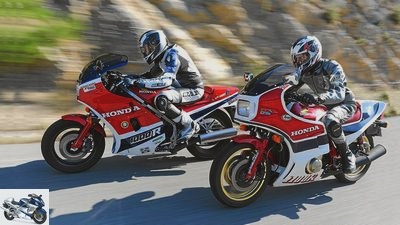
Jahn
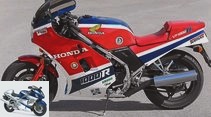
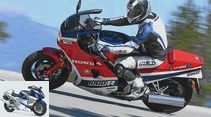
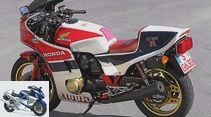
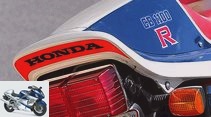
16 photos
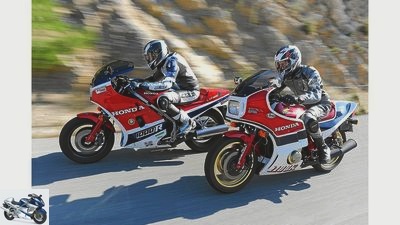
Jahn
1/16
Athletes in tails – a comparison of the two long-distance racers from the Honda brand.
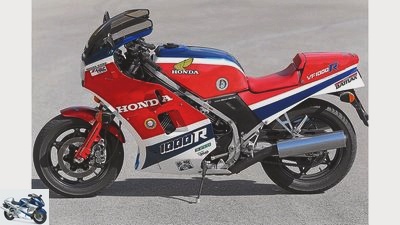
Jahn
2/16
A very fine detail borrowed from racing: the quick-release fasteners on the front wheel. TRAC? Torque Reactive Anti-Dive Control!
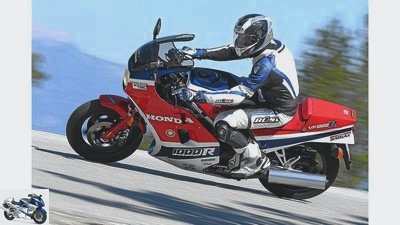
Jahn
3/16
The Honda VF 1000 R with its great and sophisticated V4 engine.
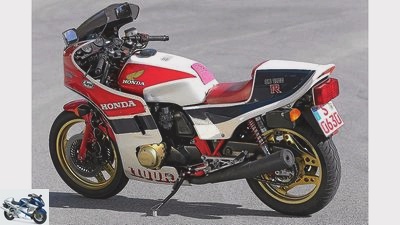
Jahn
4/16
The Honda CB 1100 R in detail.
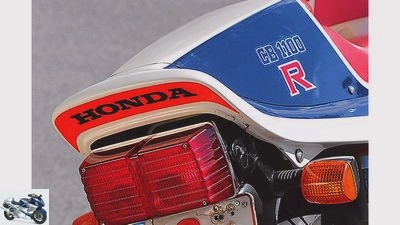
Jahn
5/16
A wide hump can handle a wide rear light – the Honda CB 1100 R..
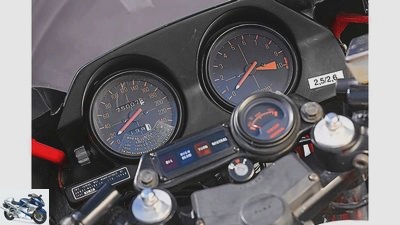
Jahn
6/16
Typically Honda: the 100 R is clear and tidy. The oil temperature gauge reassures the driver.
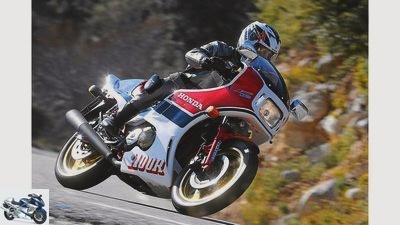
Jahn
7/16
The Honda CB 1100 R turns well.
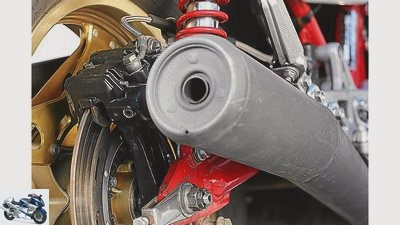
Jahn
8/16
The red painted steel swing arm of the CB 1100 R looks fragile, but does not reveal any nakedness. The matte black painted exhaust looks and sounds sporty.
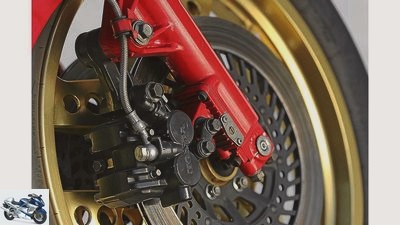
Jahn
9/16
Internally ventilated brake discs as on the CBX Pro Link and double piston calipers – well combined. Beautiful: gold anodized Comstar rims.

Jahn
10/16
Two generations compete against each other: Honda CB 1100 R and Honda VF 1000 R..
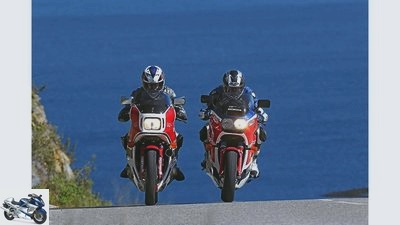
Jahn
11/16
The hunter and the hunted – the race of two generations of Honda.
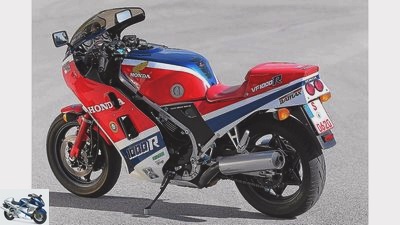
Jahn
12/16
The long wheelbase and the small wheels make the VF look stretched with the close-fitting fairing. Smart: the integrated fuel tap.
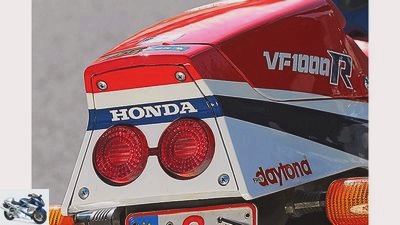
Jahn
13/16
The rear light of the Honda VF 1000 R? Unmistakable.

Jahn
14/16
The central rev counter of the VF 1000 R promises sportiness, the speedometer up to 280 only needs the open version.
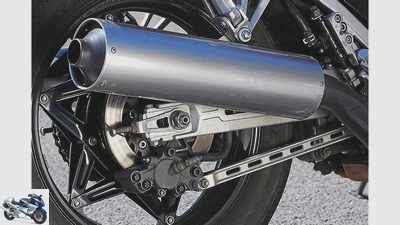
Jahn
15/16
Honda VF 1000 R: Covered mufflers, cast aluminum swingarm, bolted Comstar rim. The saddle of the internally ventilated brake disc sports a support strut.
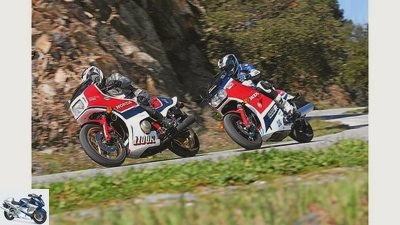
Jahn
16/16
Honda CB 1100 R and Honda VF 1000 R in comparison test.
Honda CB 1100 R and Honda VF 1000 R in comparison test
The series offshoot of the long-distance racer
Content of
The noble series offshoots Honda CB 1100 R and Honda VF 1000 R of the long-distance racers from the early 1980s are used to compare the generations. How enthusiastic can both engine and chassis philosophies still today?
The shame was deep in the late 1970s. The pride of the Honda engineers and those responsible was deeply hurt. The biggest and most important race, the Castrol Six Hours in Australia, had not been won since 1971. The competition from Suzuki, Kawasaki, Yamaha and even BMW had become too strong. The ambition was aroused to put a new, victorious racer on the wheels. In order to comply with the regulations, Honda went the opposite way for the first time: A racing machine was not developed on the basis of a production bike, but a roadworthy version of the racer was built, a homologation model in the required minimum number: the Honda C.B 1100 R was born. Initially in an edition of only 100 copies.
Honda CB 900 F Bol d’Or as the basis
The Honda CB 900 F Bol d’Or had almost imposed itself as the basis. Its four-valve engine, however, had to endure a few modifications until, in the first expansion stage, it produced an open 115, for Germany throttled 100 hp. The increase in displacement to exactly 1062 cm³, as also exhibited by the RSC factory superbikes, was carried out by means of the bore enlarged from 64.5 to 70 millimeters, the use of forged pistons, along with many other details, makes it clear that there is nothing here in terms of the best possible results was saved.
The racing success in the first year proved Honda right: In a thrilling race, the Honda CB 1100 R team Wayne Gardner and Andrew Johnson defeated the main competitors and their Suzuki GSX 1100 and secured victory in the Castrol six-hour race in 1980. The Honda CB 1100 R already underwent major changes and improvements in detail for the 1982 model year. Changed specifications of the regulations, but also the experience with the RB (factory code for the 1981 model) and logical further developments were the cause.
Sporty touring posture
The RC from 1982 driven by MOTORRAD Classic, which, like the Honda VF 1000 R, was kindly given to us by Honda fan Pit Spang, now has a clearly visible thin, ultra-light full fiberglass fairing instead of the one that is based on the Honda CB 900 F2 Half-shell, and instead of the 19-inch now an 18-inch front wheel. At the rear, a 3.00 x 18 rim should allow the use of wider racing tires instead of the 2.75. In addition, the required two-man bench with the removable pillion cover now offers the possibility, at least in theory, of transporting a passenger. The stanchions of the air-assisted Showa fork grew from the 37 millimeters of the RB by a further two to 39 millimeters (original Bol d’Or: 35 mm), and a mechanical anti-dive system should prevent the front from dipping too deeply when braking . Because of the expected higher top speed due to the aerodynamically sophisticated, very streamlined fairing, the RC now also got a slightly longer final transmission.
Enough of the theoretical explanations of how the picture-perfect racer could even come about – start off to the comparison drive. Bright sunshine, winding roads galore, snow-covered Germany is far away. Nevertheless, the morning temperature is kept within limits at three degrees plus, the Honda CB 1100 R needs full choke operation and can still be asked two or three times until it comes to Potte, shaking and still a bit clumsy. Two or three small throttles, after 30 seconds the idiosyncratic choke lever on the left end of the handlebars can be turned back, a stable idling of the mechanically clearly audible row four sets in.
Honda CB 1100 R without speed airs
Hearty, but not too loud, it also grumbles from the matt black painted end pots. The sitting posture on the Honda CB 1100 R is anything but super sporty and would at best pass under touring today: Even the mighty, elongated 26-liter aluminum tank doesn’t really disturb the dresser posture, because the half-height, adjustable handlebar stubs force the driver in an only moderately crouched posture, the footrests that are not too high fit perfectly with the feel-good arrangement. The long-distance racer lives up to its class with the ergonomics it offers.
The Honda CB 1100 R sets itself in motion without any air of speed, the clutch does not require screw clamp hands, the transmission does not require any rough steps, the four-cylinder pulls through cleanly and energetically from 2000 tours, and gentle rolling is even below this threshold. But a racer is not built for strolling around, so after a careful warm-up phase, whereby the oil temperature gauge donated for 1982 helps, performance can also be demanded.
Chassis instills confidence straight away
The first taster turns have been completed, the chassis instills confidence right away: No tilting, no folding, no bitching – the pace is faster, even if the once promised, possible 50 degree incline is certainly not tried. On the other hand, the Metzeler tires, which are no longer entirely fresh, and the not always sparkling clean asphalt speak against this. However, short intermediate sprints on the straights show that the 1100 is still good in the forage despite its mileage of around 75,000 kilometers. From medium speeds of around 4000 to 5000 rpm, it works more vigorously, accompanied by increasingly pronounced vibrations, which, contrary to the criticism in earlier test reports, I do not find annoying at all. Expressions of life of an engine, the mechanical parts of which run with a lot of play ex works.
Jahn
The hunter and the hunted – the race of two generations of Honda.
The maximum output is 9000 rpm, but whoever shifts at a good 7000 tours usually has enough pull on the rear wheel for more than brisk progress, at least off the racetrack. If the pilot moves far forward, his knees hit the side panels, wide spreading is the order of the day, but you can enjoy an offensive driver posture close to the handlebars. And cornering is fun, because the moderate tire dimensions make it easier to tip over in an inclined position, the stable chassis (unlike the Bol d’Or, the right beam is welded to the frame instead of screwed) and the successful design, a high degree of neutrality and precision Offer. In short: the Honda CB 1100 R drives the way the driver wants it to be, without a disturbing life of its own. Only alternating curves driven at high speed reveal the high gyroscopic forces of an 18-inch front wheel, the turning requires some effort and is not quite as nimble.
The Honda CB 1100 R, which is inherently quite tight, should be driven with a soft setting. You should keep your fingers off the air support of the fork so as not to harden it unnecessarily. For country roads that are “normally” maintained, responsiveness and picking qualities are completely sufficient, the RC rarely gets stuck. The Showa shock absorbers, which can be adjusted in terms of damping (compression and rebound), with compensation reservoirs, with their tight basic setting, also point to the field of racing and offer just acceptable comfort even in the softest setting. The brake, which was once considered to be flawless, with the internally ventilated brake discs at the front and, a novelty, the double-piston calipers, looks a bit blunt, toothless in our example and can only be carried away to decelerate by a strong pull on the lever.
A touch of pit lane
With this in mind, we switch from the winding streets on the French coast to the hinterland, to the nearby, traditional Paul Ricard race track. Not to do laps there, but rather to sniff the glorious racing atmosphere, and not least because of the great route there, with the fast, long curves. As if happy to be let off the leash, the Honda CB 1100 R happily sweeps along the track at well over 100 km on the country road, as if it was already smelling pit lane air.
The oil temperature remains loosely around 80 degrees on the passages driven quickly in third and fourth gear, now the fairing, which has been optimized in the wind tunnel, can prove how well it protects against the wind when you are slightly crouched. In the close-fitting, chrome-plated mirrors you can hardly see more than your own shoulders, but what should come from behind? Maybe the Honda VF 1000 R? The successor who, with her V4, was to change the guard for the four-in-a-row in racing and who broke new ground with the 16-inch front wheel? Hardly likely. Finally, colleague Stefan on the VF drives in front and sets a brisk marching pace.
Jahn
Two generations compete against each other: Honda CB 1100 R and Honda VF 1000 R..
When we arrive at the racetrack, we treat ourselves to a short coffee stop, the hot engines crackle in the cold wind. The bikes are immediately surrounded, a Frenchman confesses with shining eyes that he owned both of them, back then, over 25 years ago. Today he drives the ZX-10R, but can hardly tear himself away from the Honda CB 1100 R..
Going on, the change to the Honda VF 1000 R immediately makes it clear how differently sportiness is defined here. You have to stretch far over the tank to the narrow, strongly cranked (also adjustable) handlebar stubs, the rear hangs low, the rider’s rear too. And the feet? You are desperately looking for the notches that are very high and too far forward to enable a harmonious sitting posture. How was that with the grindstone? The idea for the VF 1000 R is based on the successful long-distance racer FWS 1000, which dominated the Daytona 200 in 1982. Greetings from Michael Baldwin and Freddie Spencer. With the V4 you had a slim engine that offered a lot of potential in terms of performance, and the 16-inch front wheel promised enormous handling advantages.
Sonor humming, slightly grumpy
Of the 117 hp of the open version (from 1985: 122) officially only 100 remained in Germany, but the engine was the real star of the VF from the start. After all, it was able to shine with highlights derived from racing, such as the gear-driven camshafts – a solution that always guarantees exact control times even at high engine speeds and thus enables a high level of power output. The character of the series engine, which, by the way, starts extremely willingly cold and warm and runs smoothly immediately, does not reveal any real racing manners. It beguiles with its sonorous humming, slightly growling sound, accompanied by the grinding of the gears of the camshaft drive. Smooth running is its strength, slight vibrations occur at most after around 6000 tours, in the area in which the V4 also increases its performance slightly. Splendid.
I find myself occasionally shifting gears later than necessary, cranking the engine a little higher to enjoy this addicting sound from medium revs. With an impressive 272 kilograms with a full tank, the engine has no trouble, the driver sometimes does. A long wheelbase and the stable aluminum box swing arm ensure good straight-line stability, but due to the barely arched, 120 millimeter wide 16-inch model at the front, the narrow handlebars and the perceived top-heavy weight distribution, the VF has to be forcefully forced into corners. Anyone who miscalculates and has to brake in an inclined position even more has a problem – the Honda VF 1000 R clearly positions itself.
The bull and the cog
Jahn
A very fine detail borrowed from racing: the quick-release fasteners on the front wheel. TRAC? Torque Reactive Anti-Dive Control!
Clearly, the SC 16 (type code) requires a concentrated driving style, a clean line. The Bridgestone BT 45s assembled today leave little to be desired, the powerful, air-assisted 41 fork (also with anti-dive) is more of the softer variety, and the rear shock absorber can even be adjusted using an easily accessible Bowden cable. This changes little in terms of the VF’s tendency to pump and rock on bumps. A timely, courageous pull on the lever before the curve reveals the qualities of the double-piston brakes at the front. Not optimally dosed and without the last bite, but there is a decent delay for a late braking.
The rear, internally ventilated disc hardly shows any effect even when you step hard. No matter. It doesn’t have to win races these days, and the Honda VF 1000 R can always fascinate and arouse the desire to buy. With its beautiful overall appearance, its technical finesse, great workmanship and the characterful, great sounding V4. Honda impressively made up for the aforementioned disgrace in racing and later celebrated many successes. And with the two racing offshoots Honda CB 1100 R and VF 1000 R, legendary icons were created that still inspire today. Definitely.
In detail: Honda CB 1100 R (SC 08)
Jahn
The Honda CB 1100 R turns well.
(1982-1983)
Price 1982: 15,755 marks
Data (Type SC 08)
Engine: Air-cooled four-cylinder four-stroke in-line engine, two overhead, chain-driven camshafts, four valves per cylinder, actuated via bucket tappets, displacement 1062 cm³, output 74 kW (100 PS) at 9000 rpm
Power transmission: multi-disc oil bath clutch, five-speed gearbox, chain drive
Landing gear: Double loop frame made of tubular steel, telescopic fork at the front, Ø 39 mm, two-arm swing arm made of tubular steel, two spring struts, Comstar composite wheels, tires 100/90 V 18 at the front, 130/80 V 18 at the rear, double disc brake at the front, Ø 265 mm, double-piston caliper, disc brake at the rear
Mass and weight: Wheelbase 1490 mm, weight with a full tank of 264 kg
Driving performance: Top speed 224 km / h
technology
The CB 1100 R was developed on the basis of the 900 Bol d’Or, so some large-scale parts fit, but much of the 1100 has been specially revised. The engine was brought to 1062 cm³ displacement by boring from 64.5 to 70 millimeters. Forged pistons and new connecting rods work inside, the compression has been increased from 8.8 to 10: 1 and the valve timing has been changed. In addition, modified crankshaft main bearings and a wider primary tooth chain are used, and new 33-millimeter Keihin carburetors ensure the mixture. A stiffer double loop frame made of steel with now welded instead of screwed beams ensures stability. The red painted tubular steel swing arm of the RC (1982) had to give way to an aluminum box swing arm for the RD (1983). The throttling from open 120 to 100 HP was only done via the welded panels in the end pots. The internally ventilated brake discs in the front and the unnecessary mechanical anti-dive system are more technical gimmicks than necessary. In contrast, the new double-piston calipers have proven to be useful. Concessions to lightweight construction: the lighter alternator and the battery with lower capacity (12 Ah instead of 14 Ah).
Checkpoints
Many original parts are difficult or impossible to get any more. The chrome-plated mirrors in particular are now outweighed by gold as used parts. Interested parties should attach particular importance to the original exhaust and the good condition of the paintwork. Be careful with exchange parts: The painted parts are not identical, the RC model comes in solid paint with a different color code than the RD model (metallic paint). The upper part of the fairing of the RD is also shorter at the front. If the oil consumption exceeds the tolerable level and a set of oversized pistons is required, it becomes difficult. There have long been no pistons from Honda, the conversion to 72 mm Wiseco pistons (then 1123 cm³) is a good and frequently used alternative. Basically, almost everything is possible, possibly from the standard Bol d ‘Or customizable, yet costs can skyrocket.
market
Only 1500 pieces of the SC 08 models 1982 (RC) and 1983 (RD) were built, of the half-wired predecessor SC 05 only 1050. Accordingly, the CB 1100 R is rarely found as a used one. The KBA has a total of just 180 registered vehicles. Rebuilt or tinkered CBs can occasionally be found for 3,000 to 4,000 euros; really well-kept originals are unlikely to be available for less than 7,000 to 8,000, often for more than 10,000 euros.
Specialists / parts
Team d‘Or
Phone 09 11/56 79 98 08,
www.teamdor.com
www.davidsilverspares.co.uk
Clubs and forums
www.boldorclub.de
www.cb1100r.com
www.cb1100r.de
history
1981: The half-faired original version of the CB 1100 R (SC 05) from 1981 with an open 115 HP still rolled on a 19-inch front wheel and was a pure single-seater.
Price: 15 126 marks
1983: The CB 1100 F Super
Bol d‘Or offered the 100 HP engine of the CB 1100 R and a thick 39 fork, but also standard parts of the 900 Bol d‘Or.
Price: 11 178 marks
In detail: Honda VF 1000 R
Jahn
The Honda VF 1000 R with its great and sophisticated V4 engine.
(1984-1986)
Price 1984: 18,218 marks
Data (Type SC 16)
Engine: Water-cooled four-cylinder, four-stroke, 90-degree V-engine, two overhead, gear-driven camshafts, four valves per cylinder, rocker arm, displacement 998 cm³, 74 kW (100 PS) at 9000 / min
Power transmission: Multi-disc oil bath clutch, five-speed gearbox, chain drive
Landing gear: Double loop frame made of steel, telescopic fork in front, Ø 41 mm, two-arm swing arm made of aluminum box profiles, central spring strut, Comstar composite wheels, tires 120/80 V 16 front, 140/80 VR 17 rear, double disc brake front, Ø 276 mm, double-piston floating caliper, disc brake back
Mass and weight: Wheelbase 1505 mm, weight with a full tank of 272 kg
Driving performance: Top speed 238 km / h
technology
The 1000 series, especially the V4 engine of the top model, showed off technical high-end solutions in 1984: Unlike the sister model VF 1000 F, the R gear wheels drive the camshafts instead of the timing chain. Time-consuming and expensive, but reliable. The latter did not apply to the V4 engines in general, especially at the beginning; their reputation was initially dubious. The VF 1000 R is also affected. The problem with pitting and running-in camshafts was due to insufficient surface hardening and poor oil supply. Defective camshafts can be overhauled, but crankshafts are no longer available. The installation of an oiling kit promises an improvement in the oil supply: This ensures that freshly filtered oil is fed directly to the camshafts and that these are not the last place in the supply in the oil circuit. Speaking of oil: Experts recommend mineral 20W-50 instead of the often used thin synthetic oil. The models from 1985 onwards received a larger water cooler and an oil cooler and are considered to be thermally healthier, while the oil supply is safer due to a modified oil pump and oil pan. If you want to be absolutely sure when it comes to cooling, you can install another thermal switch that activates the fan earlier or install a manual switch. Alex Nolte from Maniac-Motors is the top address for technical inquiries, modifications and parts. Anyone who wants to convert to 17-inch wheels from the CBR 600 F (PC 25) can also turn to him: modern tires will then fit, and the 17-inch front wheel will improve the 1000’s handling enormously.
Checkpoints
Tip for the tour: Listen to the engine with a screwdriver as a stethoscope. In the event of rattling or rumbling noises, the source can be localized more precisely. An alleged crankshaft damage sometimes turns out to be damage to the torsion springs of the camshaft drive, which is easier and cheaper to repair. Be careful when inflating the air-assisted fork: it is all too easy to blow the sealing rings through here. Beware of engine damage: The heads of the different years of construction have different widths and are not easily compatible. One should keep this in mind when buying used parts.
market
According to Japanese sources, almost 9200 copies were produced, only a small part of them went to Germany. The KBA currently has 111 registered vehicles. Ready-to-drive VFs can be found from around 3000 euros. Rare and sought-after 1986 versions in Rothmans livery are rarely offered for less than 6000 euros, if at all. The same applies here: Note the original condition. Painted parts, mufflers or even the screwed Comstar rims are difficult to find and expensive.
Specialists / parts
Alex Nolte / Maniac Motors
Telephone 09 11/9 69 49 83,
www.maniacmotors.de
Volker Lorenz
Telephone 051 44/97 23 21
www.lo-moto.de
Clubs and forums
www.vf1000r.com
www.v4-ig.de
history
1984: The basic version VF 1000 F has to get by with chain-driven camshafts, but is also good for touring. In 1985 there was the more harmonious 18-inch model at the front. Price: 12 198 marks
1985: The fully faired VF 1000 F2 marks the comfortable travel variant of the V4 series with an 18-inch front and a heavily redesigned engine and chassis. Price: 13,998 marks
Strengths and weaknesses
Jahn
Honda CB 1100 R and Honda VF 1000 R in comparison test.
| Honda CB 1100 R. | Honda VF 1000 R. | technology |
| reliability | 7/10 | 6/10 | Driving behavior | 8/10 | 5/10 |
| Performance | 7/10 | 8/10 | Suitability for everyday use | 6/10 | 5/10 |
| Repair friendliness | 7/10 | 5/10 | market |
| Availability | 2/10 | 3/10 | demand | 8/10 | 7/10 |
| Spare parts supply | 4/10 | 4/10 | Used price level | 7/10 | 6/10 |
| Value forecast | 9/10 | 8/10 | emotion |
| Driving fun | 8/10 | 6/10 | Sound | 7/10 | 8/10 |
| character | 8/10 | 8/10 | design | 8/10 | 7/10 |
| Cult potential | 9/10 | 8/10 |
Related articles
-
Comparison test KTM 990 Supermoto versus Ducati Hypermotard 1100
Mayer comparison test KTM 990 Supermoto versus Ducati Hypermotard 1100 Supermoto duel Crass edges or curved lines: With the Hypermotard 1100 …
-
factstudio.de 15th photos factstudio.de 1/15 Honda CB 1000 R + in the top test. factstudio.de 2/15 The design line of the new CB 1000 R is called “Neo…
-
Honda VFR 800 F in the top test
25 pictures Montero 1/25 The cap pulls out gasoline by suction (negative pressure), it is opened when the tank is almost full or half full …
-
On the move: Honda VF 1000 R, Kawasaki GP Z 900 R, Suzuki GSX-R 1100
Jahn On the move: Honda VF 1000 R, Kawasaki GP Z 900 R, Suzuki GSX-R 1100 Technical revolution Content of They drove us crazy – and saved us money:…
-
Top test Moto Guzzi Breva V 1100
Jahn Top-Test Moto Guzzi Breva V 1100 Brave Breva With the Breva V 1100 a new era begins for Moto Guzzi. And for BMW grows for the first time …
-
Double test Honda CB 400-Yamaha SR 250
Double test Honda CB 400 / Yamaha SR 250 Looking back to the front Reconsideration as a forward strategy is also very much in vogue in the small class. Two…
-
Comparison test Honda Fireblade, VTR 1000 SP-2
Artistic comparison test Honda Fireblade, VTR 1000 SP-2 Everything stays different Honda is the only motorcycle manufacturer to produce two 1000cc super sports …
-
Comparison test: Honda CX 500-650 Turbo, Kawasaki Z 750 Turbo, Suzuki XN 85, Yamaha XJ 650 Turbo
Jahn 21 pictures Jahn 1/21 The preload of the central spring strut of the Suzuki can be easily adjusted. Jahn 2/21 Tight corners and fast …
-
Endurance test Honda VFR CBS-ABS
Bilski long-term test Honda VFR CBS-ABS The all-round carefree package The rough edges of the VFR are limited to the outside. Sit on it and feel good means …
-
Triumph Street Triple R, Honda Hornet 600 and Ducati Monster 1100 Evo in the test
fact 17 pictures fact 1/17 The Triumph Street Triple R, Honda Hornet 600 and the Ducati Monster 1100 Evo compete against each other. Which of them is the …